Time Blocking Templates
Free Time Blocking Templates in Excel & Google Sheets brought to you by Replicon, the Time Intelligence® platform.

“If you don’t control your calendar, your calendar will control you.” ~ Mark Batterson
When you juggle multiple responsibilities throughout the day, ranging from endless meetings, replying to emails, collaborating with co-workers, and receiving ad-hoc tasks, your productivity levels rarely work the way you want.
This is where time-blocking templates can do wonders.
Time blocking is a technique that splits the day into chunks of time, and all the activities to be done are distributed across these time chunks. Thus, it helps you stay focused on a task for a specified period without getting distracted easily.
To help you with this, we’ve compiled a list of time-blocking templates to plan your days efficiently and gain better control over your time.
Here are free time-blocking templates from Replicon for daily, weekly, bi-weekly, and monthly calendars. These are downloadable, printable and available in multiple formats. These can help you schedule your entire tasks and activities on a daily/weekly/monthly basis in advance. However, these templates either use time boxing or the day theming method.
So, before moving to the templates, check out the basic difference between time blocking and day theming.
Time Blocking: It divides the entire day into multiple and equal chunks of time. Each block is dedicated to pursuing a specific task or similar activities.
Day Theming: Day theming is used in the monthly templates and is useful for people who deal with multiple areas of responsibility rather than numerous tasks. In day theming, the user can devote an entire day to a certain area of business/activity/responsibility.
For example, a marketing manager has to oversee multiple areas, such as product marketing, SEO, content marketing, paid marketing, campaign, and sales; thus, they can dedicate each day of the week to work on one of those areas.
Daily Time-Blocking Template
Our daily time-blocking template divides the entire day into 30-minute time chunks. These chunks or blocks can be assigned to activities you need to accomplish in a day.
Our template has a to-do list table with columns for tasks, descriptions, and notes. You can assign each block to different tasks mentioned in this to-do list.
Here are the instructions on how to use the daily time-blocking template:
- First, mention all the tasks that you have to perform in the to-do list section.
- Now, start assigning one or more blocks to each task from the to-do list.
- Tasks that may take more time to finish can be assigned 2-3 time blocks.
- Consider adding break time after a few blocks to relax and recharge.
- As you start working on different tasks, keep updating the status of each task in the to-do list section.
Note: We’ve also put the columns of ‘description’ to better explain the task, ‘status’ to show the progress of the task and ‘notes’ to mention additional details.
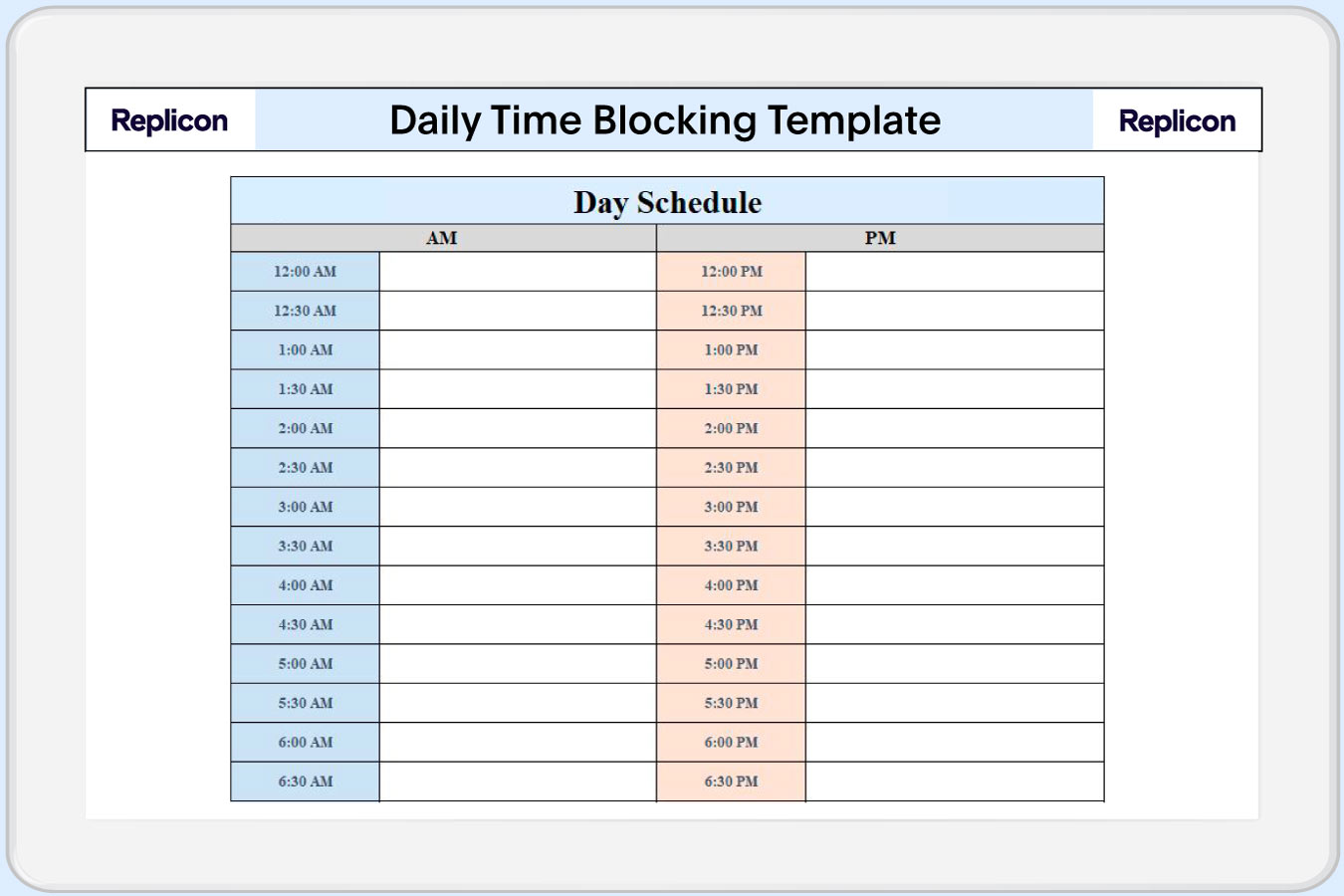
Weekly Time-Blocking Template
Our weekly time-blocking template helps you schedule your entire week with 30-minute time blocks in advance.
Weekly time-blocking templates are beneficial when you want to have a bigger picture of your entire week’s plan beforehand. We have broken down the time into five days of the week; however, some weekly templates include weekends in addition to weekdays, so we have covered that with both 5-day and 7-day weekly templates.
1. Five-Day Time-Blocking Template
This template splits the week into a total of five work days rather than seven. Since most organizations operate five days a week, this template is suitable for employees who get weekends off.
In this template, all five days are split into one-hour time blocks over a 24-hour period.
- Mention all the tasks/activities that need to be covered in a week in the to-do list.
- Now, start assigning one or more blocks to each of these tasks.
- Assign all the time blocks of five days with tasks from the to-do list.
- As you start working on different tasks, keep updating the status of each task/project in the to-do list section.
As the week progresses, you can evaluate how much time each task is taking. Then you can use this analysis to revise the schedule for the next time.
Note: We’ve also put the columns of ‘description’ to better explain the task, ‘status’ to show the progress of the task and ‘notes’ to mention additional details.
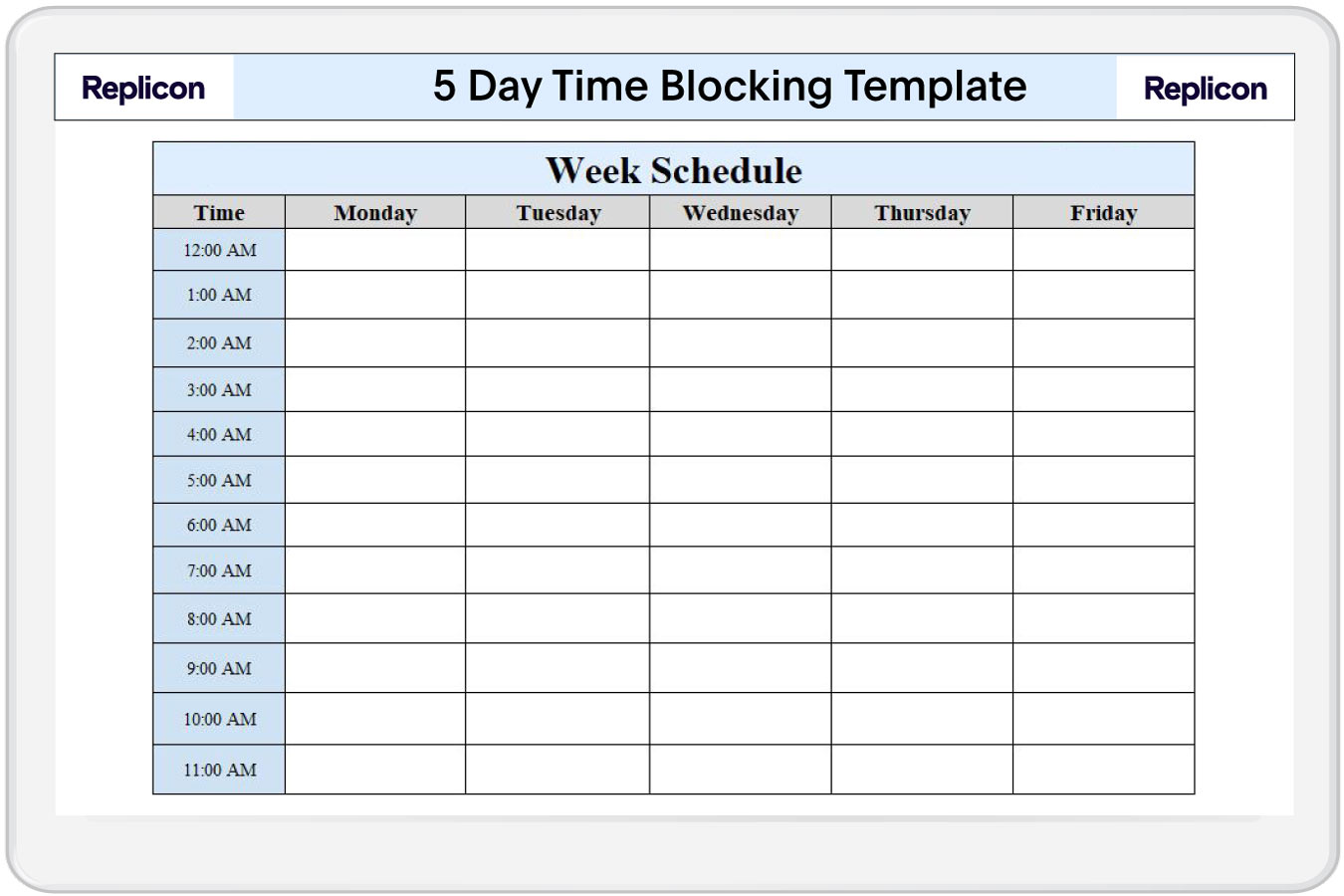
2. Seven-Day Time-Blocking Template
In case, you want to plan weekends in addition to workdays, then this seven-day time-blocking template can fit the bill. This time-blocking template includes all days of the week and is especially useful for freelancers, entrepreneurs, or employees with irregular workday schedules. This template comprises seven days, and each day is divided into blocks of 1 hour over a 24 hr period.
- Mention all the tasks/activities/projects that you need to work on during these seven days in a to-do list.
- Now, start assigning one or more blocks to each task from the to-do list.
- Repeat the process until you fill the blocks of all the seven days.
- As you start working on different tasks, keep updating the status of each task/project in the template.
Note: We’ve also put the columns of ‘description’ to better explain the task, ‘status’ to show the progress of the task and ‘notes’ to mention additional details.
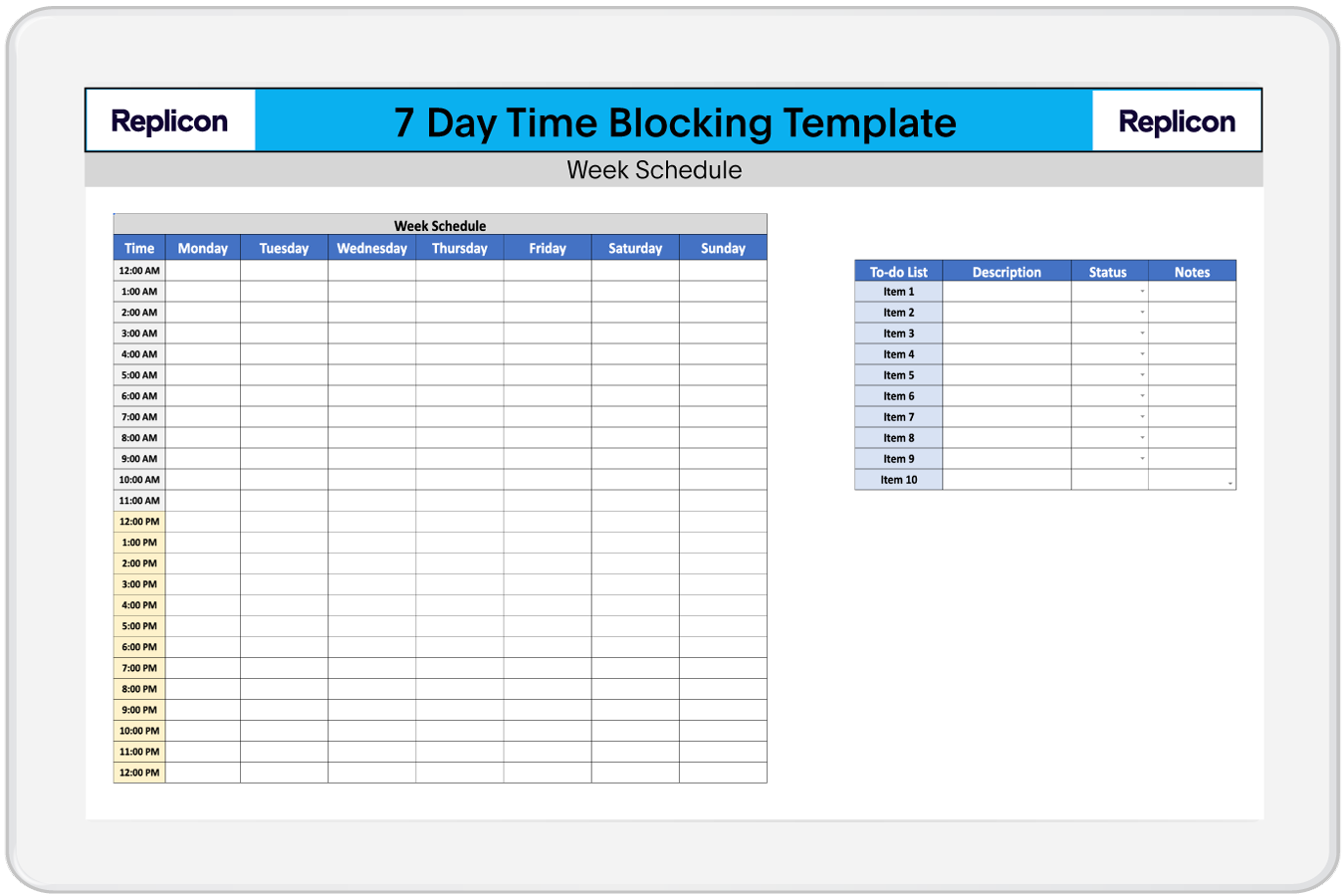
Bi-Weekly Time-Blocking Template
This template operates on a bi-weekly basis, i.e., it has time blocks for 14 days. However, there are generally five workdays in a week, so the template features five workdays of two weeks each, namely from Monday to Friday.
Unlike the weekly template, this one doesn’t have an hourly basis division for each day. Instead, the template comprises 10 days (of two weeks), and each day can be assigned a major area of responsibility.
Simply put, this template uses the day theming method that allows each day block to be allocated with a specific task/activity.
For instance, the content team can work on blogs and articles on Monday & Tuesday, and they can focus on PR development on Wednesday. At the same time, Friday can be utilized to work on emails and customer newsletters.
Here are the steps on how to use a bi-weekly template from Replicon:
- First, mention all the areas you need to work on or projects that you need to take up during this two-week time frame in a to-do list.
- You can also give detailed descriptions and additional notes on each area of work for better comprehension.
- Now, as per the day theming, start updating the blocks with the items (project or area of responsibility) from this to-do list for all 10 days.
- As you start working on different tasks/activities, keep updating the status of each task/project in the template.
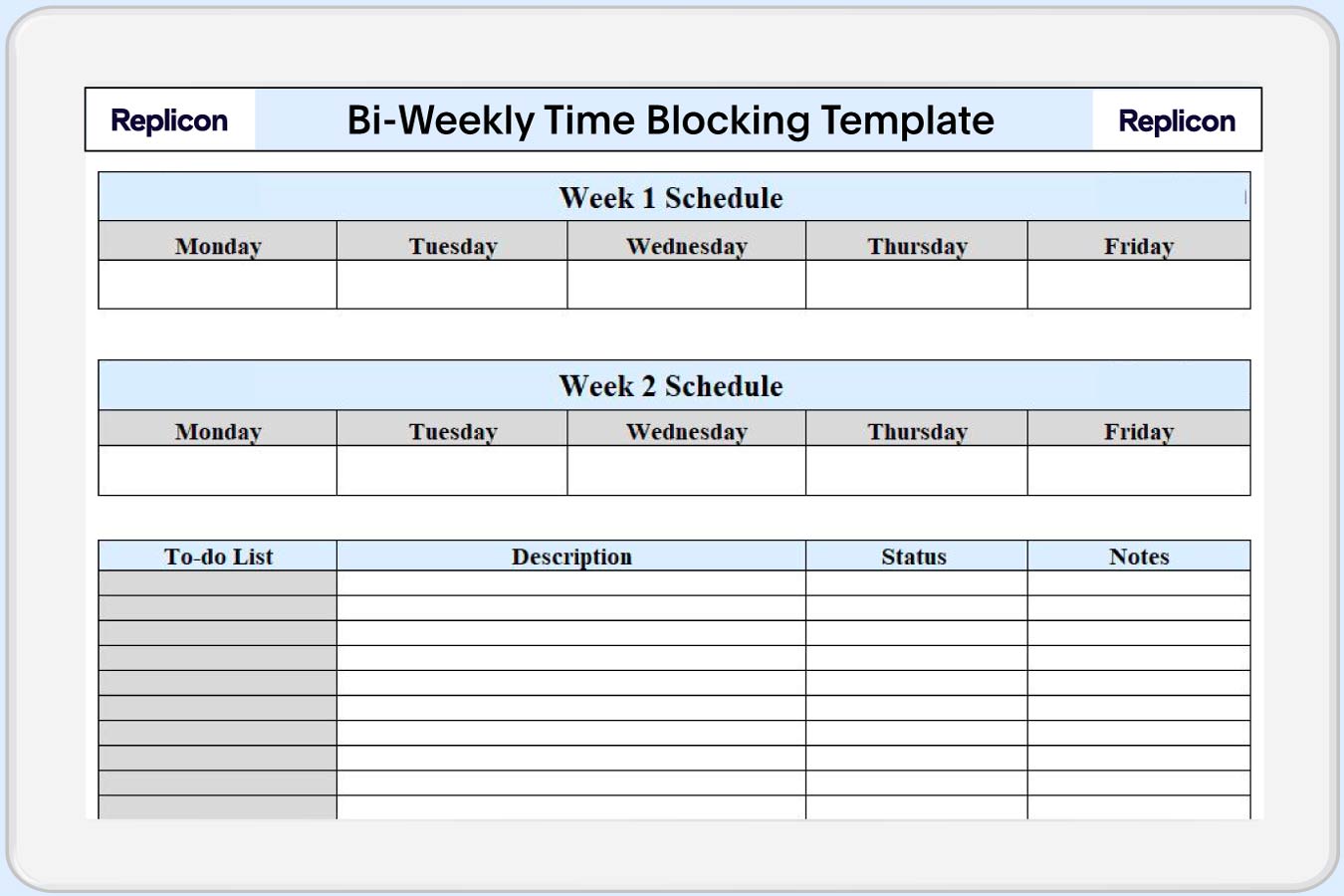
Monthly Time-Blocking Template
The monthly time-blocking template provides a holistic view of the entire month’s schedule. Such templates work well for freelancers or managers who are managing long-term projects.
Like a bi-weekly template, this monthly template does not split days on an hourly basis; instead, it leverages the day-theming method. It also has a to-do list where you can add major responsibilities or areas that need to be worked on during a month.
- You can input all activities/areas/projects in a to-do list along with their descriptions, status, and notes.
- Then, you can assign each day a specific item from the to-do list. For instance, a to-do list can have PR writing, Blog writing, Email writing, Social media post writing, etc. One or two of these items can be added against each day as a part of day theming.
- Update all 31 days of the month with specific work areas from the to-do list.
- You can also update the status of each item in the to-do list once they are completed.
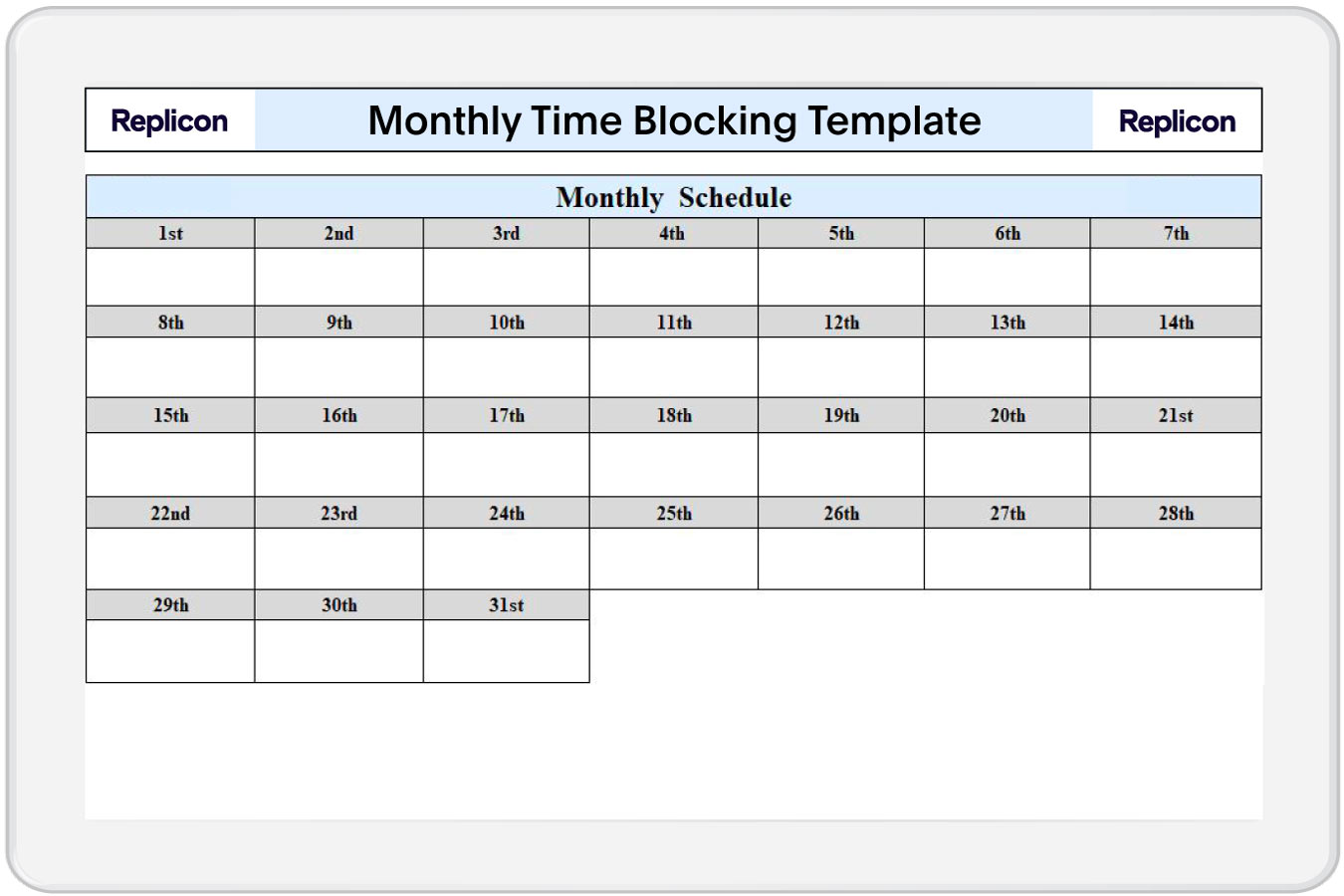
What Is Time Blocking?
Time blocking is the practice of planning out all the activities of your day in advance by dedicating certain time blocks to each of the tasks. Time blocking is a time management strategy in which you allocate a stipulated amount of time to all the activities that you have to accomplish in a day/week/month.
In other words, time blocking is a method that divides your entire day/week/month into multiple time chunks and each time chunk is blocked to pursue a specific activity or task.
Time blocking helps you identify, organize, and schedule all the tasks of a day in advance based on their priority so that you can focus on one task at a time. Each time block is dedicated to completing a certain task or sub-task, thus eliminating the need for context switching. Time blocking insists on monotasking for a time duration rather than multitasking, which is one of the major productivity killers.
Why Use Time-Blocking Templates?
A time-blocking template is an easy way to organize and plan your activities for a day/week/month. These templates come with time blocks of fixed intervals that can be allotted for activities you need to complete in a day, week or month.
The time blocks can be of 15, 30, or 60 minutes depending on the type of tasks you deal with. Especially for people who juggle multiple projects simultaneously, this template helps dedicate ample time to all the projects. Interestingly, the templates can also be customized to tailor to the specific needs of the user.
The time-blocking template can help you complete more work in less time, ensuring maximum productivity and efficiency. Besides, these templates can help you track your tasks’ progress and analyze your time usage in a day/week/month.
How to Use Time-Blocking Template Effectively
- As a basic step, think of all the tasks you need to take up and note them down.
- Once you’ve gathered all the tasks in a single place, prioritize them as per the urgency and importance. You can number them as 1, 2, 3 etc., in descending priority order.
- Identify the shallow tasks that need to be done immediately but do not add to the primary work or project, such as email, meetings, etc. Try to batch them and assign them on a single block.
- If the tasks are time-consuming, then consider dividing them into sub-tasks.
- Add all these tasks to a to-do list of the template, and add some additional notes and descriptions for better understanding.
- Now, start filling the blocks one by one with the tasks from the to-do list section. Make sure to allot break time to some blocks after the completion of 2-3 tasks.
- Analyze which part of the day you feel most productive, and schedule the priority tasks on the blocks of that time span.
- Once you start using the template, analyze which tasks are taking longer than mentioned and which are taking shorter time than anticipated. Analyze this data and note it somewhere. This evaluation will help you better plan your schedule.
- Also, update the status of each task in the to-do list once they’re completed.
- You may likely derail from the set schedule due to delay in the task, contingency, or even tiredness. Use the statistics of how much time each task may take to plan the template better next time.
Significance of Time-Blocking Template
1. Helps You Attain Deep Focus State
When you organize your schedule and allot fixed time to all the tasks, then you can easily focus on your work. Whether you have multiple things to work on or have to work on tasks with closer deadlines, assigning fixed time to tasks helps you concentrate on one task at a time, without dividing your attention across several tasks.
So, time blocking allows you to organize your tasks in blocks as per urgency and priority, without the need to multitask.
2. Allows You to Evaluate Your Productivity and Time Usage
When you start using a time-blocking template as a beginner, you may likely overestimate or underestimate the time required to complete the tasks. This is because you may not predict the contingency, difficulty level, distractions, or ad-hoc work requests that may pop up along the course.
It’s advised that as a beginner, you should divide your tasks into subtasks and assign more time to each task. Besides, consider reserving some blocks for break time, and avoid filling all your blocks with multiple tasks one after another. Breaks are crucial to restore your productivity and creativity.
You can also consider incorporating techniques, such as the Pomodoro technique, while working with the template. With continuous template usage, you can better predict the time allocation for each task, and master the skill of time management.
3. Cut Down the Time of Shallow Work
Shallow work consists of urgent tasks that don’t have any major contribution to any project. These tasks can be responding to emails, helping colleagues in their work, coordinating with teams or stakeholders, etc.
Armed with time blocking, you can assign one time block to all such shallow work in batches, thus reducing the need for context switching. This will prevent distractions while working on deep-focus work.
Time blocking is a perfect way to plan your day,week or month in advance for better time management. You can leverage the time-blocking daily, weekly, bi-weekly, and monthly templates from Replicon to structure and plan your day effectively and get more done in less time.